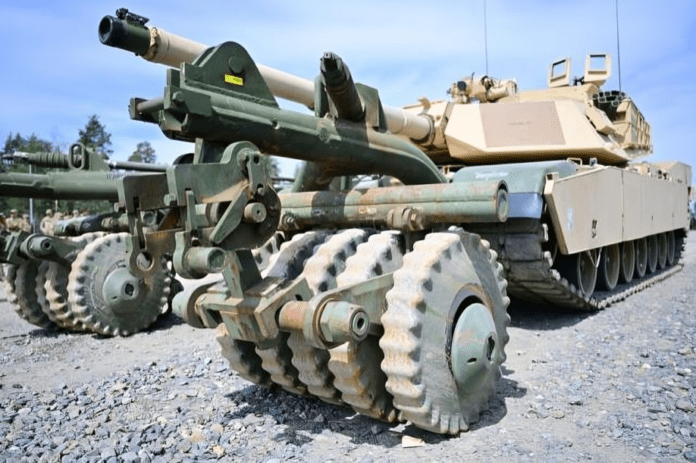In a jarring shift driven by the rapidly evolving battlefield, Ukraine has been forced to sideline the fearsome U.S.-supplied Abrams M1A1 main battle tanks from the crucible of its grinding war against Russia’s invading force. The impetus? A relentless onslaught of Russian drones that has rendered these elite armored behemoths incredibly vulnerable to detection and devastating attacks, according to two U.S. military officials cited by The Associated Press.
The arrival of the cutting-edge Abrams tanks on Ukrainian soil just months ago sparked hopes that these $10 million apiece juggernauts could breach Russia’s formidable defensive lines. Kyiv had lobbied tenaciously for their deployment, adamant that the powerful tanks represented a vital key to regaining territory seized by Moscow’s forces.
But the sands have dramatically shifted on Ukraine’s battlefields in recent months. A scourge of Russian unmanned aerial eyes in the skies, ranging from surveillance drones to hunter-killer combat drones, has made it increasingly untenable for the Abrams to operate undetected. Their movements can be instantly tracked from above, drawing devastating attacks.
Five of the 31 Abrams tanks rushed to Ukraine’s aid have already been destroyed by Russian strikes according to officials. One senior U.S. defense official bluntly conceded that in the face of the ubiquitous drone presence “there isn’t open ground that you can just drive across without fear of detection.”
With the twin banes of airborne sensors and precision weaponry denying them freedom of maneuver, the Abrams tanks – once billed as heavy metal heroes – have been prudently pulled off the front lines for the time being. A remarkable reversal of fortune for the armored sledgehammers that were supposed to spearhead Ukraine’s offensives.
“When you think about the way the fight has evolved, massed armor in an environment where unmanned aerial systems are ubiquitous can be at risk,” admitted the vice chairman of the Joint Chiefs of Staff, Adm. Christopher Grady, in a recent AP interview.
Grady emphasized that while tanks remain crucial weapons, a wholesale “reset” is needed for Ukraine’s daring tank crews to survive and succeed against Russia’s drone Cancer that has metastasized across the battlefield. “We’ll work with our Ukrainian partners, and other partners on the ground, to help them think through how they might use that, in that kind of changed environment now, where everything is seen immediately.”
The relocation of the powerful Abrams tanks from the front comes as the U.S.-led Ukraine Defense Contact Group coalition hits the two-year mark. Formed to assess Ukraine’s needsand channel military aid from some 50 nations, the group is now focused on countering Russia’s increasingly effective use of inexpensive drones as deadly missile trucks and aerial spies.
The latest $1 billion U.S. military package approved by President Biden underscores this armed drone skirmish mindset. It is heavy on counter-drone capabilities like specialized .50 caliber anti-drone rounds, additional air defenses, and a range of more affordable armored vehicles like Humvees and Bradley fighting vehicles. Critically, the package also includes the first Americantactical ballistic missiles for Ukraine – the long-range Army Tactical Missile Systems (ATACMs) that can strike deep behind enemy lines from relative safety.
The reasoning is clear: With massed Ukrainian armor inhibited by dense drone surveillance coverage, these ATACMs and disposable armored truck-tanks offer standoff strike ability and safer transport for infantry squads tasked with clearing Russian positions.
However, one anonymous official suggested that in addition to the dire drone threat, Ukraine’s lack of training in coordinated “combined arms” assaults has hindered the Abrams’ employment. Designed to spearhead multi-pronged offensives melding tanks, infantry, artillery and airpower, the Abrams proved ill-suited to Ukraine’s more plodding operational art and attrition tactics.
After the Pentagon first unveiled its $400 million plan to provide 31 Abrams tanks to Ukraine in January 2023, a six-week-long training program commenced for Ukrainian crews at Germany’s Grafenwoehr base. There they learned to operate and maintain the 70-ton Abrams – but also how to integrate its firepower into the multi-domain combined arms battlespace.
Yet even as this training unfolded, Ukraine’s much-anticipated spring counter-offensives bogged down in the face of skillful Russian defenses. This setback only fueled greater urgency among Ukrainian officials to rush the Abrams into battle in hopes the tanks’ raw punching power could restore momentum.
Zelenskyy himself hailed the Abrams’ arrival in Ukraine that September. But the tanks’ employment has been sporadic and piecemeal at best, never massed as originally envisioned. Poor training, sloppy combined arms coordination, and Russian drone ubiquity all conspired to undermine the touted Abrams advantage.
The faulty tactics came to a head during Ukraine’s withdrawal from Avdiivka – a city in the eastern Donbas region that endured months of bloody fighting. Several of Ukraine’s dwindling Abrams fleet were lost there to Russian strikes, with the outgunned crews forced to carefully ration ammunition due to delayed Western aid shipments. At times defenders could only fire back sporadically at every fifth or sixth Russian barrage, the official divulged.
So while the vaunted Abrams tanks were expected to form a vanguard for Ukrainian offensives and breakthroughs, they’ve become another high-risk, high-value target that Russia’s budget drone armadas can abuse at will unless smarter doctrine and integrated air defense bubbles are mustered for their protection.
It’s a sobering lesson in the unforgiving realities of modern combined arms warfare – where traditional, big-gun theory runs headlong into a more nimble, distributed form of robotic combat cloud perfected by Russia through its Syrian and Ukrainian crucibles.
Even as Ukraine’s allies rush to supply tank-killing drones and expand training for combined arms offensives, Russia’s swarming drone-missiles remain a deadly wild card that has reasserted the primacy of air superiority and integrated defenses on the 21st century battlefield.
For now, withdrawal and reassessment is the prudent path for Ukraine’s Abrams танки until Russian drone omniscience can be adequately addressed. The road to challenged and regaining the grand armored maneuver warfare of Desert Storm remains arduous. But such temporal tactical pivots, however surprising, may be the key to eventually unleashing the full fury of the vaunted Abrams.























